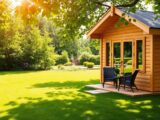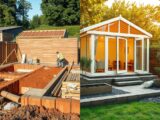Choosing the Best Roof Types for Garden Sheds Guide
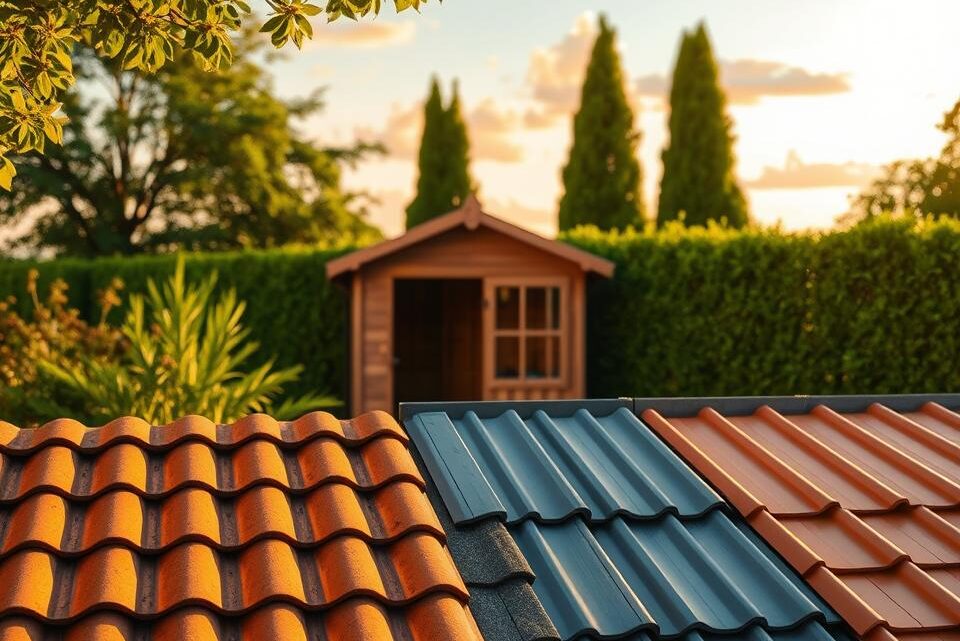
Selecting the right garden shed roofing can make the difference between a watertight storage space and constant repair headaches. British weather demands careful consideration when choosing shed roof designs that will protect your tools, equipment, and gardening supplies year-round.
The perfect roof combines durability, affordability, and visual appeal. From traditional apex designs to modern flat options, UK shed roofing options suit every budget and style preference. Your choice impacts not just the shed’s appearance but its longevity and maintenance needs.
This guide explores weatherproof shed roofs that stand up to rain, wind, and occasional snow. You’ll discover practical solutions for outdoor storage protection that match your specific needs. Whether you’re building from scratch or replacing an existing roof, understanding your options saves time and money.
Inhaltsverzeichnis
Key Takeaways
- Climate plays a crucial role in selecting appropriate shed roof designs for UK conditions
- Budget planning helps balance initial costs with long-term value for your roofing project
- Popular options include apex, pent, flat, and curved roofs, each with distinct advantages
- Material choices range from traditional felt to modern EPDM rubber solutions
- Professional installation may be worth considering for complex weatherproof shed roofs
- Regular maintenance extends the life of any outdoor storage protection system
- Building regulations affect shed height and placement near property boundaries
Understanding Your Garden Shed Roofing Needs
Selecting the right roof for your garden shed requires careful consideration of several key factors. Your choice will impact not only the shed’s appearance but its durability and functionality for years to come. Before making any decisions, it’s essential to evaluate your specific requirements based on climate, intended use, and available budget.
Climate Considerations for UK Weather
The unpredictable nature of UK weather conditions plays a crucial role in roof selection. Britain experiences an average of 133 days of rain annually, with some regions receiving up to 1,500mm of precipitation. Your shed weatherproofing strategy must account for persistent moisture, occasional heavy snowfall, and autumn storms that can bring winds exceeding 60mph.
When planning for British climate roofing, consider these weather-related challenges:
- Frequent rainfall requiring excellent water drainage
- Temperature fluctuations causing material expansion and contraction
- Strong coastal winds demanding secure fixing methods
- Snow loads in northern regions needing reinforced structures
Shed Usage and Purpose
Your shed’s intended purpose directly influences roofing requirements. A simple storage shed has different needs compared to a workshop or garden office. Consider ventilation for workshops to prevent condensation, while hobby rooms might require insulation for year-round comfort. Rain-resistant roofs become even more critical for sheds housing electrical equipment or valuable tools.
| Shed Purpose | Key Roofing Requirements | Recommended Features |
|---|---|---|
| Storage Only | Basic weatherproofing | Simple felt or corrugated sheets |
| Workshop | Ventilation and durability | Ridge vents, skylights |
| Garden Office | Insulation and aesthetics | Shingles with underlayment |
| Potting Shed | Light and drainage | Polycarbonate panels |
Budget Planning for Your Roof Project
Establishing a realistic budget helps narrow down suitable options. Factor in initial material costs, installation expenses, and long-term maintenance. Wind-resistant shed designs might cost more upfront but save money on repairs after storms. Quality British climate roofing materials typically range from £15-£50 per square metre, excluding labour.
Popular Roof Types for Garden Sheds
Selecting the right roof style transforms your garden shed from a simple storage space into an attractive outdoor feature. Each design offers distinct benefits for water drainage, interior space, and visual appeal. Let’s explore four popular options that suit different needs and preferences.
Apex Roofs: The Classic Choice
The apex shed roof remains Britain’s favourite choice for garden buildings. Its distinctive triangular shape features two sloping sides that meet at a central ridge, creating excellent rainwater runoff. This traditional shed roofing style provides generous headroom in the centre, making it perfect for workshops or storage areas where you need to stand comfortably.
The steep pitch naturally sheds rain and snow, reducing maintenance needs throughout the year. Many homeowners appreciate how this classic design complements period properties and traditional gardens.
Pent Roofs: Modern and Practical
A pent roof design slopes in just one direction, offering a contemporary alternative to traditional styles. This single-slope construction works brilliantly when positioning your shed against a wall or fence, as the highest point faces outward for easy access.
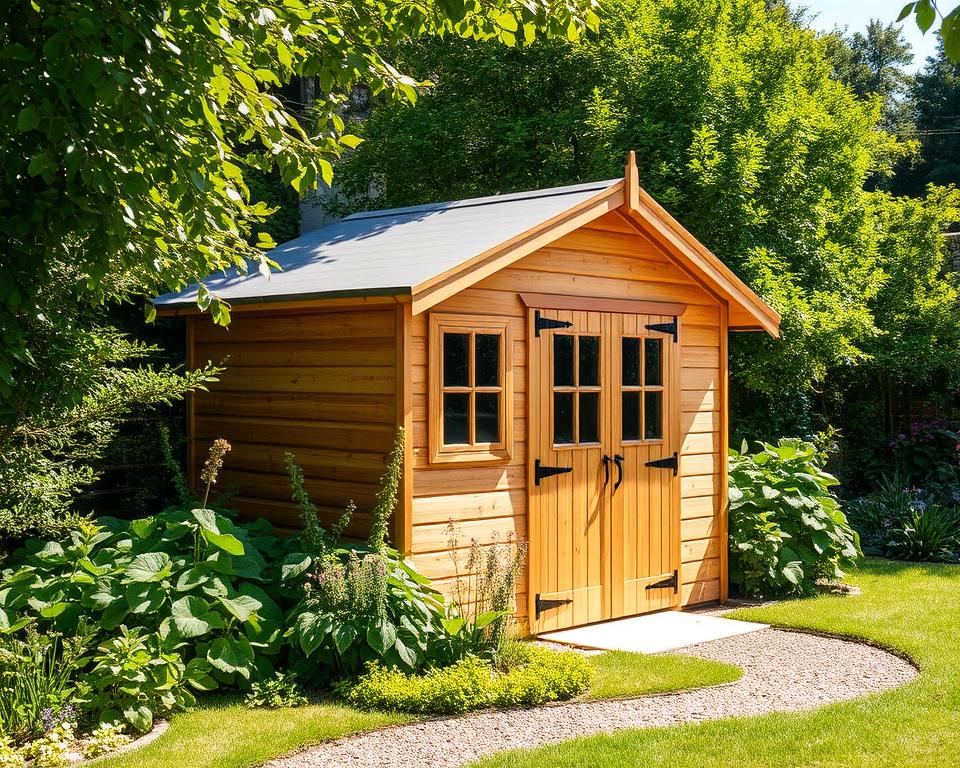
The streamlined profile suits modern gardens and provides efficient water drainage towards the back. Interior space remains practical, with the tallest section typically positioned at the entrance.
Flat Roofs: Simple and Cost-Effective
Flat roof sheds deliver clean lines and straightforward construction. Despite their name, these roofs feature a slight gradient for water drainage. They maximise interior height across the entire floor space, making them ideal for smaller gardens where every centimetre counts.
Curved Roofs: Stylish and Unique
Curved roof options bring architectural flair to any garden. The gentle arc provides superb water runoff whilst creating surprising headroom throughout the interior. These distinctive structures often become focal points, adding character beyond basic storage needs.
Materials for Garden Shed Roofing
Selecting the right material for your garden shed roof is crucial for ensuring long-lasting protection against the unpredictable British weather. Each material offers distinct benefits in terms of cost, durability, and appearance. Understanding these options helps you make an informed decision that suits both your budget and your shed’s specific requirements.
Felt Roofing: Traditional and Affordable
Roofing felt continues to be a favourite amongst UK homeowners due to its low cost and straightforward installation process. This traditional material typically provides reliable protection for five to ten years when properly maintained. Available in various grades, from basic mineral felt to premium torch-on varieties, it suits most garden shed applications perfectly.
Metal Roofing: Durable and Long-Lasting
Metal shed roofs represent excellent value for those seeking longevity. Corrugated steel and aluminium sheets can withstand harsh weather conditions for twenty to thirty years with minimal upkeep. These waterproof roofing materials resist moss growth and require only occasional cleaning to maintain their appearance.
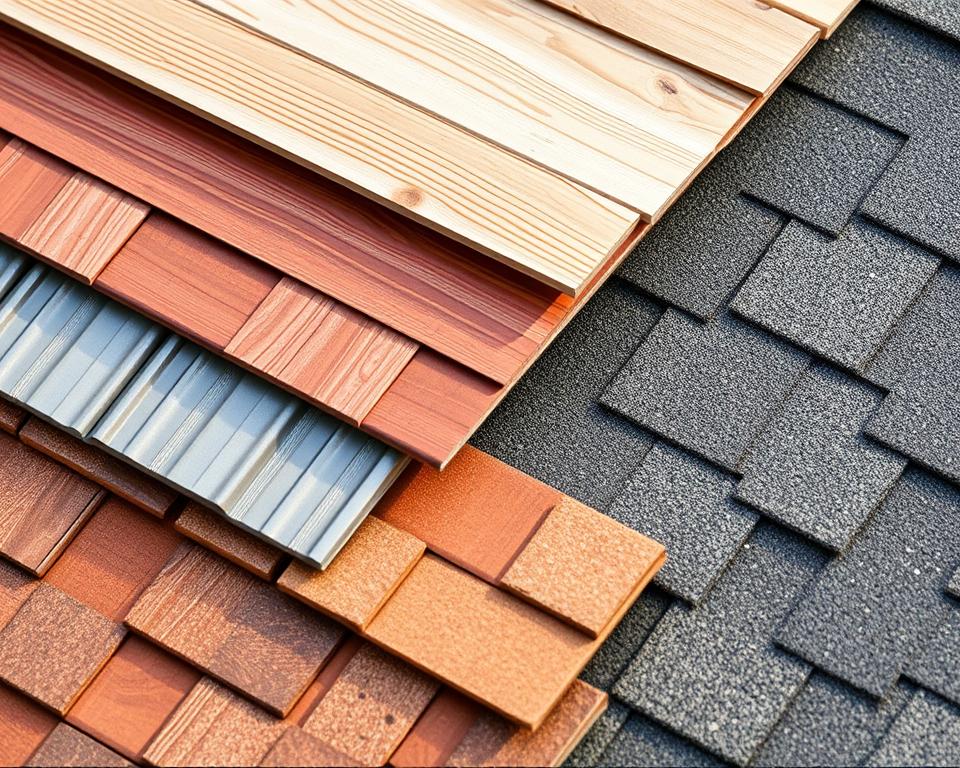
Shingle Roofing: Attractive and Weather-Resistant
Asphalt shingles bring aesthetic appeal to garden sheds whilst providing robust weather protection. These versatile materials come in numerous colours and styles, allowing your shed to complement your home’s appearance. Quality shingles typically last fifteen to twenty years in British conditions.
EPDM Rubber: Modern and Waterproof
EPDM rubber roofing stands out as a premium choice for complete waterproofing. This synthetic material offers exceptional durability, often exceeding twenty-five years of service life. Its seamless application eliminates potential leak points, making it ideal for flat or low-pitched shed roofs.
| Material Type | Average Lifespan | Cost Range | Maintenance Level |
|---|---|---|---|
| Roofing Felt | 5-10 years | £15-30 per roll | Moderate |
| Metal Sheets | 20-30 years | £25-40 per sheet | Low |
| Asphalt Shingles | 15-20 years | £30-50 per m² | Low-Moderate |
| EPDM Rubber | 25+ years | £40-60 per m² | Very Low |
Advantages of Different Shed Roof Designs
Selecting the right shed roof involves understanding the unique roof design benefits each style offers. Your choice impacts both functionality and aesthetics, making a thoughtful roofing style comparison essential for your garden project.
Apex roofs provide exceptional interior space with their triangular design. The high central ridge creates generous headroom, perfect for tall storage solutions or workshop activities. This classic design efficiently sheds water and snow, reducing maintenance concerns throughout the year.

Pent roofs excel in gardens with height restrictions or narrow spaces. Their single-slope design directs water runoff to one side, making gutter installation straightforward. These modern structures offer excellent shed roof advantages for contemporary gardens where space comes at a premium.
Flat roofs transform unused space into functional areas. You can create a green roof with plants or install solar panels for sustainable energy. Despite their name, these roofs feature a slight pitch for drainage, combining simplicity with versatility.
| Roof Type | Best For | Key Advantage |
|---|---|---|
| Apex | Storage & Workshops | Maximum headroom |
| Pent | Small gardens | Space efficiency |
| Flat | Multi-use spaces | Rooftop potential |
| Curved | Unique aesthetics | Wind resistance |
Curved roofs combine style with practicality. Their aerodynamic shape resists strong winds whilst creating an attractive focal point. Water runs off smoothly, reducing pooling risks. Making an optimal roof choice depends on balancing these practical benefits with your specific needs and preferences.
Installation Considerations and Requirements
Installing a shed roof requires careful planning and the right approach. This comprehensive roof installation guide covers everything from choosing between DIY shed roofing and hiring professional roofers to understanding essential safety measures. Making informed decisions about installation methods, roofing tools, and safety equipment ensures your project runs smoothly and produces lasting results.
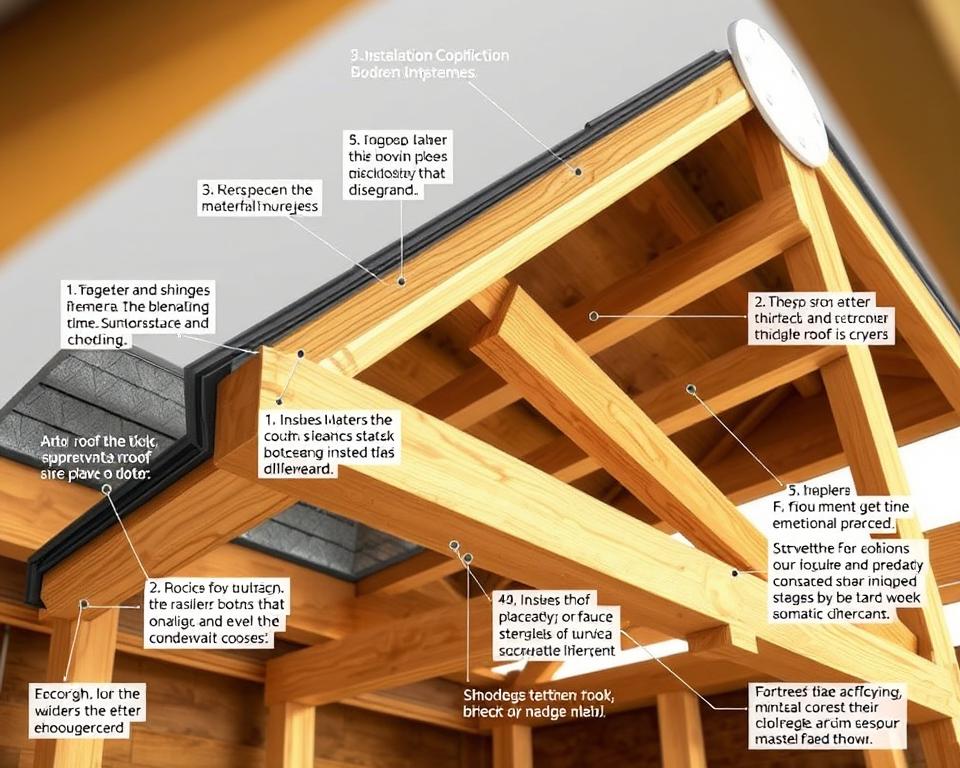
DIY vs Professional Installation
Deciding between DIY shed roofing and professional installation depends on your skills, time, and budget. DIY installation can save you £300 to £800 on labour costs if you possess basic carpentry abilities. You’ll need confidence working at heights and understanding measurements.
Professional roofers bring expertise in weatherproofing techniques and building regulations compliance. They complete jobs faster, typically finishing in one to two days. Professionals carry insurance, protecting you from liability if accidents occur.
| Installation Type | Cost Range | Time Required | Best For |
|---|---|---|---|
| DIY Installation | £150-£400 | 2-4 days | Simple roofs, experienced DIYers |
| Professional Installation | £500-£1,200 | 1-2 days | Complex designs, warranty seekers |
Tools and Equipment Needed
Proper roofing tools make installation safer and more efficient. Essential equipment includes:
- Claw hammer and roofing nails
- Circular saw or handsaw
- Spirit level (minimum 1.2 metres)
- Measuring tape and chalk line
- Utility knife for cutting materials
- Drill with appropriate bits
Safety Precautions and Best Practices
Safety equipment protects against common roofing hazards. Always wear non-slip footwear, work gloves, and safety glasses. Set ladders at a 75-degree angle and secure them properly. Never work alone—have someone steady ladders and pass materials.
Weather conditions affect safety significantly. Avoid installation during rain, strong winds, or icy conditions. Schedule work for dry mornings when dew has evaporated. Take regular breaks to prevent fatigue-related accidents.
Weatherproofing Your Garden Shed Roof
Protecting your garden shed from the UK’s unpredictable weather starts with proper weatherproofing. A waterproof shed roof shields your belongings from rain, snow, and moisture that can cause rot and damage. Getting this right saves money and extends your shed’s life significantly.
Start with quality underlayment beneath your chosen roofing material. This creates an essential barrier against water penetration. Overlap each section by at least 150mm and secure edges with appropriate roof sealants. Silicone-based products work brilliantly for sealing joints and nail holes in our damp climate.
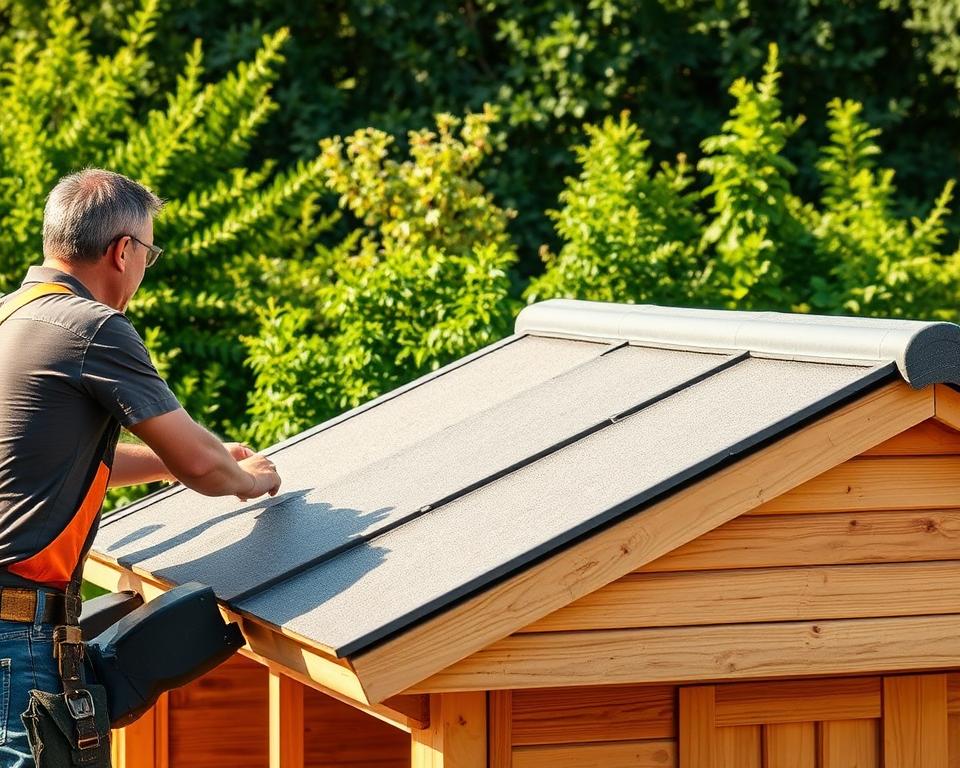
Installing proper guttering systems directs rainwater away from your shed’s foundation. Even a basic plastic gutter prevents water pooling around the base, which causes wood rot and structural problems. Position downpipes to discharge water at least one metre from the shed walls.
Ventilation solutions play a crucial role in weatherproofing. Without adequate airflow, condensation builds inside your shed, damaging tools and creating mould. Install ridge vents or soffit vents to maintain air circulation. This balance between keeping water out whilst allowing air movement proves essential for weather-resistant roofing.
- Apply waterproof membrane before final roofing material
- Seal all edges and penetrations with flexible sealant
- Check gutters regularly for blockages
- Ensure 50mm minimum roof overhang for rain protection
Regular inspections catch small issues before they become expensive repairs. Check sealants annually and reapply where needed to maintain your weatherproofing system.
Cost Comparison of Roofing Options
Selecting the right roofing for your garden shed involves balancing upfront shed roofing costs with long-term value. Understanding the financial implications of each option helps you make an informed decision that suits your budget whilst ensuring your shed remains protected for years to come.
Initial Investment vs Long-Term Value
When evaluating budget roofing options, it’s essential to look beyond the initial price tag. Felt roofing starts at £15 per square metre, making it attractive for immediate savings. Metal roofing ranges from £25-50 per square metre but offers exceptional longevity. This roofing value comparison shows that spending more initially often results in fewer replacements and repairs.
| Roofing Material | Cost per m² | Expected Lifespan | Annual Cost (20-year period) |
|---|---|---|---|
| Felt | £15-30 | 5-10 years | £3-6 |
| Metal | £25-50 | 20-30 years | £1.25-2.50 |
| Shingles | £20-40 | 15-20 years | £1.33-2.67 |
| EPDM Rubber | £40-60 | 25-30 years | £1.60-2.40 |
Hidden Costs to Consider
Beyond material prices, several expenses can impact your total investment. Underlayment materials add £5-10 per square metre. Fixings and fasteners typically cost £20-40 per project. Waste disposal fees range from £50-150, depending on your location. Professional installation doubles or triples material costs, making these cost-effective materials less affordable without proper planning.
Money-Saving Tips for Shed Roofing
Smart shopping strategies can significantly reduce expenses:
- Purchase materials during winter months when demand drops
- Buy roofing supplies in bulk for 10-20% discounts
- Prepare the roof structure yourself before professional installation
- Compare quotes from multiple suppliers for competitive pricing
- Consider slightly imperfect materials at reduced rates
Maintenance Requirements for Each Roof Type
Keeping your garden shed roof in top condition doesn’t have to be complicated. Each roofing material has its own roof maintenance schedule that helps extend its lifespan and prevents costly repairs down the line.
Felt roofs need the most attention amongst common shed roofing options. Check them yearly for tears, bubbles, or loose edges. Apply a protective coating every three to five years to maintain waterproofing. Small shed roof repairs like patching holes can prevent bigger problems later.
Metal roofs are low-maintenance champions. Inspect them twice yearly for rust spots or loose screws. A quick scrub with a soft brush removes dirt buildup. Touch up any scratches with matching paint to prevent corrosion.
Shingle roofs benefit from regular moss and algae removal. Replace cracked or missing shingles promptly to avoid leaks. Clear gutters and valleys of leaves to ensure proper drainage – this simple preventive maintenance task makes a real difference.
EPDM rubber roofs are practically maintenance-free. An annual sweep to remove debris and a quick check of the seams is usually sufficient. These modern materials offer excellent value with minimal upkeep.
Following these roof longevity tips helps your shed roof last its full potential lifespan. Regular inspections catch small issues before they become expensive problems. Set reminders for seasonal checks – your shed (and wallet) will thank you!
Building Regulations and Planning Permission
Before constructing your garden shed roof, it’s crucial to understand the UK building regulations that apply to your project. Navigating these rules ensures your shed complies with local standards and avoids potential legal issues down the line.
UK Building Standards for Sheds
Most garden sheds fall within *permitted development rights*, meaning you won’t need formal approval for smaller structures. UK building regulations typically don’t apply to sheds under 15 square metres in floor area. Sheds between 15 and 30 square metres may need building control approval, particularly if they contain sleeping accommodation or are positioned close to your home.
When Planning Permission is Required
Planning permission requirements become necessary in specific circumstances:
- Your property is in a conservation area or is a listed building
- The shed exceeds 50% of your garden area
- You’re placing it in front of your house
- The structure will be used for business purposes
Height Restrictions and Boundary Rules
Shed height limits vary depending on location within your garden. If positioned within 2 metres of any boundary, the maximum height is 2.5 metres. For sheds placed further from boundaries, you can build up to 4 metres high with a dual-pitched roof, or 3 metres for other roof types. These restrictions ensure neighbourly relations remain positive whilst maximising your permitted development rights.
Enhancing Your Shed Roof’s Appearance
Your garden shed doesn’t have to be purely functional. With thoughtful design choices, you can transform its roof into an attractive feature that complements your outdoor space. The right combination of colours, finishes, and decorative elements can elevate your shed from a simple storage unit to a charming garden focal point.
Colour Choices and Finishes
Selecting the perfect shed roof colours requires careful consideration of your property’s existing palette. Grey slate-effect shingles work brilliantly with Victorian and Edwardian homes, creating a cohesive look across your garden aesthetics. For contemporary properties, charcoal or anthracite finishes offer a sleek, modern appeal.
Natural tones deserve special attention. Green felt or shingles help your shed blend seamlessly into leafy gardens, whilst terracotta and brown options complement rustic settings. Consider these popular colour combinations:
- Sage green roofing with cream or white shed walls
- Charcoal grey roof with natural wood cladding
- Rustic red tiles with stone or brick-effect walls
- Deep blue roofing for coastal-themed gardens
Decorative Elements and Accessories
Roof accessories can add personality and charm to your shed. Ridge tiles in contrasting colours create visual interest along the roofline. Finials at gable ends provide Victorian elegance, whilst weathervanes offer traditional countryside appeal.
Consider these architectural details to enhance your decorative roofing:
- Ornamental barge boards in white or contrasting colours
- Copper or zinc-effect guttering for premium appeal
- Solar-powered uplighters to highlight roof features
- Window boxes beneath eaves for added charm
Matching Your Home’s Aesthetic
Creating visual harmony between your shed and main house strengthens your property’s overall appeal. Match guttering colours to your home’s downpipes – black uPVC suits modern properties, whilst white works with traditional styles. Small details make significant differences in achieving professional results.
Study your home’s architectural details carefully. Tudor-style homes benefit from dark timber effects and decorative brackets. Modern minimalist properties call for clean lines and monochrome palettes. By echoing your home’s design language, your shed becomes an intentional garden feature rather than an afterthought.
Common Roofing Mistakes to Avoid
Building a garden shed roof might seem straightforward, but many DIY enthusiasts fall victim to costly roofing errors that lead to serious shed roof problems down the line. Understanding these common pitfalls helps you create a weatherproof structure that stands the test of time.
One of the most frequent installation mistakes involves creating an insufficient roof pitch. A pitch below 10 degrees often causes water to pool rather than drain properly, leading to premature deterioration of roofing materials. This standing water seeps through joints and causes structural damage that could have been easily prevented.
Poor material overlap represents another critical error when avoiding roof damage. Roofing felt should overlap by at least 100mm on horizontal joints and 150mm on vertical ones. Skimping on overlap to save materials invariably results in leaks during heavy rainfall.
Ventilation often gets overlooked, yet inadequate airflow causes condensation to build up inside the roof space. This moisture creates ideal conditions for rot and mould growth. Installing simple eaves vents or a ridge vent prevents this damaging cycle.
*Never compromise on fixings quality*. Using too few nails or choosing cheap alternatives leads to loose materials during storms. Follow manufacturer specifications for spacing and use galvanised nails designed for outdoor use.
Skipping the underlayment layer ranks amongst the worst roofing errors. This protective barrier provides essential backup protection when water penetrates the primary covering. Installing proper breathable membrane adds minimal cost whilst significantly extending your roof’s lifespan.
Conclusion
Making the best shed roof choice requires careful thought about several key factors. Your roofing decision guide should start with understanding your specific needs. Think about the British weather patterns in your area, how you plan to use your shed, and the amount you can spend. Each element plays a vital role in finding the optimal roofing solution for your garden building.
The perfect shed protection summary includes matching the right materials with the most suitable design. Apex roofs offer traditional charm and excellent water runoff. Pent roofs provide modern appeal with practical headroom. Flat roofs keep costs down whilst curved designs add unique character to your garden. Your choice should reflect both your practical needs and personal style.
Remember that the optimal roofing solution extends beyond the initial installation. Regular maintenance keeps your chosen roof performing well for years. Check for damage after storms, clear gutters regularly, and address small repairs quickly. This approach protects your investment and ensures your shed remains a valuable garden asset.
Your roofing decision guide should balance immediate costs with long-term value. Whilst felt roofing saves money upfront, materials like metal or EPDM rubber might offer better value over time. Consider your DIY skills, local building regulations, and the overall look you want to achieve. The best shed roof choice combines reliable shed protection with a design that complements your outdoor space perfectly.
FAQ
What is the best roof type for a garden shed in the UK?
The best roof type depends on your specific needs, but apex roofs are the most popular choice for UK garden sheds. They offer excellent water runoff, maximise internal headroom, and suit our rainy climate perfectly. For modern aesthetics or limited space, pent roofs work brilliantly, whilst EPDM rubber flat roofs provide superior waterproofing with minimal maintenance.
How much does it cost to roof a garden shed?
Roofing costs vary by material: felt roofing costs £15-30 per square metre, metal roofing £25-50, shingles £20-40, and EPDM rubber £40-60. For a typical 8×10 foot shed, expect to spend £150-300 for felt, £250-500 for metal, or £400-600 for EPDM, including materials and basic fixings.
Do I need planning permission for my shed roof?
Most garden sheds don’t require planning permission under permitted development rights. Keep your shed under 2.5 metres high if within 2 metres of boundaries, or under 4 metres elsewhere. However, you’ll need permission in conservation areas, for listed properties, or if your shed exceeds 15 square metres in floor area.
How long do different shed roof materials last?
Roofing felt typically lasts 5-10 years with proper maintenance, metal roofing offers 20-30 years of protection, bitumen shingles provide 15-20 years of service, whilst EPDM rubber roofing can last 25+ years. Regular maintenance and quality installation significantly extend these lifespans.
Can I install a shed roof myself?
Yes, confident DIYers with basic carpentry skills can install most shed roofs, particularly felt or shingle options. You’ll need essential tools like hammers, saws, and spirit levels, plus safety equipment. However, for EPDM rubber or complex curved roofs, professional installation ensures proper weatherproofing and may be required for warranty validity.
What’s the minimum roof pitch for a UK garden shed?
The minimum recommended pitch is 15 degrees for felt roofs and 10 degrees for metal roofing to ensure proper water drainage in the UK’s wet climate. Apex roofs typically feature 20-45 degree pitches, whilst pent roofs work well at 10-15 degrees. Anything less risks water pooling and premature material failure.
How do I stop my shed roof leaking?
Prevent leaks by ensuring proper material overlap (minimum 150mm for felt), sealing all joints with appropriate adhesives, and installing quality underlayment. Add guttering to manage runoff, check and replace damaged sections promptly, and apply protective coatings to felt roofs every 3-5 years. Regular debris clearing also prevents water pooling.
What’s the difference between apex and pent roofs?
Apex roofs feature two sloping sides meeting at a central ridge, creating a triangular profile that maximises headroom and suits traditional garden settings. Pent roofs slope in just one direction, ideal for sheds positioned against walls or fences, offering a modern appearance and simpler construction whilst maintaining good water drainage.
